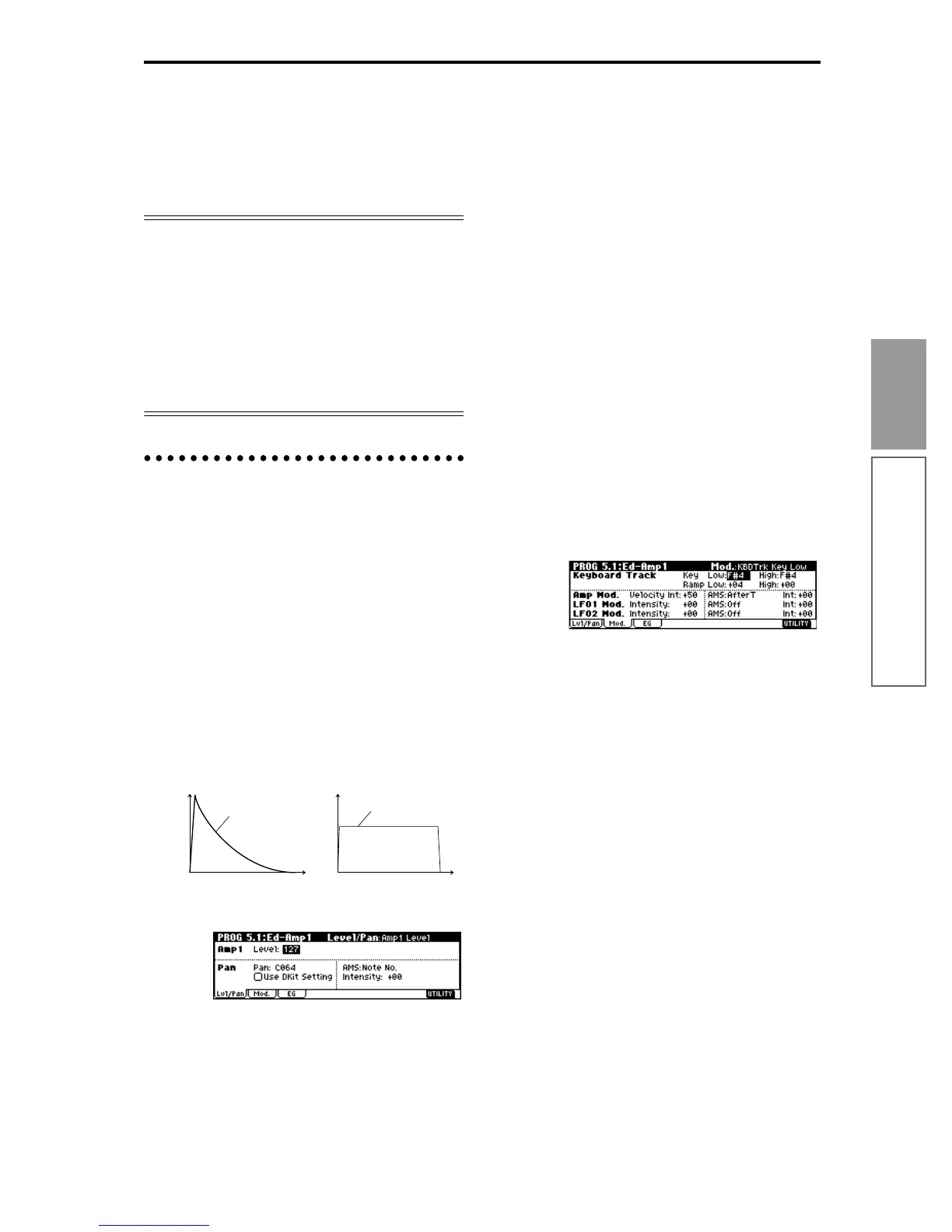49
Basic functions
Program mode
EG page
Indicates settings for the filter EG, which controls time-
variant changes in tone (☞PG p.18). Make settings for
the EG here, and set the depth of its effect in the Mod.1
page “Filter EG” parameter.
Filter EG and Amplifier EG
When the Filter EG changes the cutoff frequency, the
tone will change. However depending on the volume
changes produced by the Amplifier EG, this can be
heard in different ways. For example by changing the
speed at which the tone and volume begin (attack) or
decay, you can significantly vary the character of the
tonal change. It is a good idea to adjust the changes of
both the Filter EG (tone) and the Amplifier EG (vol-
ume) as you proceed with editing. (☞“5.1: Ed–Amp1,
EG page, 5.2: Ed–Amp2, EG page)
Amplifier settings
5.1: Ed–Amp1, 5.2: Ed–Amp2
These settings affect the volume. Here you can adjust
the way in which the Amp EG and LFO produce time-
varying and cyclic changes in volume, and how the
controllers etc. will affect the volume.
Amp1 applies to OSC1, and Amp2 applies to OSC2.
Amp2 can be used if “Mode (Oscillator Mode)” is set to
Double.
For example, the volume of a piano note begins at a
high volume the instant you play the note, and then
decreases gradually. The volume of an organ note
remains constant as long as you continue pressing the
key. The volume of a note on a violin or wind instru-
ment can be varied during the note by the musician
(i.e., by regulating the amount of pressure on the bow
or the force of the breath).
Lvl/Pan (Level/Pan) page
Amp1 Level, Amp2 Level
Adjusts the volume of the sound that has passed
through the oscillator, filter, and amp.
Pan
Specifies the pan (stereo position) after the signal has
passed through the oscillator, filter, and amp. Normally
you will set this to C064. If “Mode (Oscillator Mode)”
is Double and you wish to create a sense of stereo, set
the 5.1: Ed-Amp1 and 5.2: Ed-Amp2 parameter “Pan”
to left and right for oscillators 1 and 2 respectively.
With a setting of Random, the pan will change ran-
domly each time you play a note on this instrument,
producing an interesting effect.
AMS Intensity
“Intensity” specifies the depth of the panning effect
that will occur when “AMS” is operated.
If you set “AMS” to Note No., the pan will change
according to the keyboard position at which you play a
note on a this instrument. With a setting of LFO1 or 2,
the pan will sweep from side to side (auto pan). Other
settings allow you to move the oscillator pan by oper-
ating a controller.
Use DKit Setting
This is valid when “Mode (Oscillator Mode)” is set to
Drums. If this is checked, the pan location specified by
the Drum Kit for each drum sound will be used. If this
is unchecked, all drum sounds will sound at the same
location. Preload and GM drum kits are set to stereo
settings. Normally you will leave this checked.
Mod. page
This varies the cutoff frequency according to the key-
board location that you play.
Keyboard Track
This lets you vary the volume by the keyboard location
you play.
• When Ramp “Low” has a positive (+) value, the
volume will increase as you play lower on the
keyboard. With a negative (–) value, the volume
will decrease as you play lower on the keyboard.
• When Ramp “High” has a positive (+) value, the
volume will increase as you play higher on the
keyboard. With a negative (–) value, the volume
will decrease as you play higher on the keyboard.
Amp Mod.
“Velocity Int” is used by most programs to decrease
the volume of softly played notes and increase the vol-
ume of strongly played notes, and this Amp Modula-
tion parameter adjusts the depth of this control.
Normally you will set Amp Modulation to positive (+)
values. As this setting is increased, there will be greater
volume difference between softly played and strongly
played notes.
LFO1 Mod., LFO2 Mod.
Specify how the LFO’s will produce cyclic changes in
volume (the tremolo effect).
The volume will be affected by the LFO(s) for which
you set an “Intensity (LFO1 Intensity, LFO2 Intensity)”
value.
Volume
Time
Piano
Volume decays gradually
Volume
Time
Organ
Volume remains constant
until note is released

